Ethereum
Ethereum Bullish Pattern Signals Upcoming Rally – Analyst Sets $2,870 Target

All eyes are on Ethereum as the crypto market watches closely following Bitcoin’s recent surge. Analysts and investors are now cautiously waiting for Ethereum to catch up, with some fearing that ETH’s performance in this cycle may fall short of expectations.
Related Reading
Recent price action for Ethereum has shown signs of strength, giving investors confidence that a potential breakout could be near. Ethereum is currently trading within a bullish pattern that, if broken, could lead to a massive surge in the coming weeks.
With Bitcoin leading the way and market momentum building, ETH could be poised to follow, unlocking new gains and potentially signaling the start of a powerful rally for the altcoin.
Investors are closely watching for signs that Ethereum will break free from its consolidation and begin to climb, as it remains one of the most closely monitored assets in the market.
Ethereum Flirting With A Surge
Over the past few weeks, Bitcoin has surged, leaving investors eagerly waiting for Ethereum to follow suit. Top analyst and investor Carl Runefelt has shared his technical analysis on X, highlighting a bullish pattern emerging on Ethereum’s 1-hour price chart.
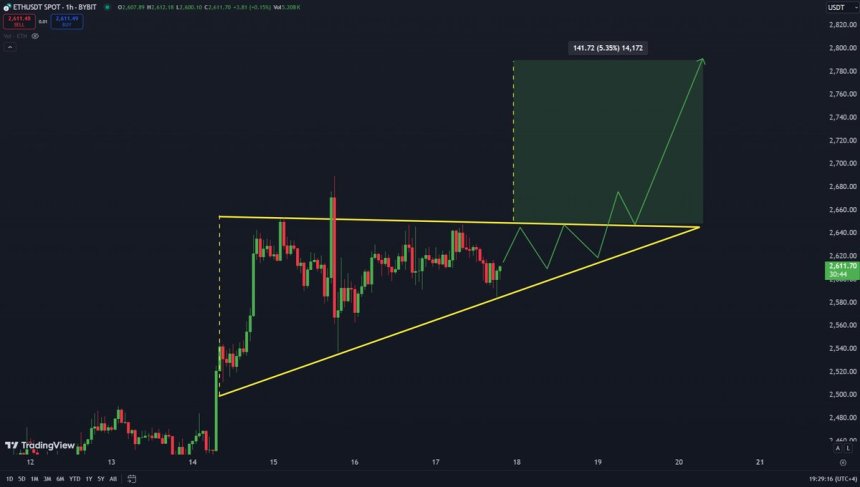
Runefelt’s analysis points to an ascending triangle formation, which is generally a bullish indicator. According to him, if Ethereum manages to break above this pattern, a rapid surge to $2,870 could be imminent.
This price level represents a key target for Ethereum, as it signals a strong upward move and confirms that the altcoin is catching up with Bitcoin’s recent performance.
However, there are still risks that Ethereum could continue to trade sideways if it fails to break the current resistance level. In that case, ETH could remain trapped in consolidation for a longer period, which would cause further frustration among investors hoping for a rally.
Related Reading
Despite these risks, market conditions favor Ethereum’s potential breakout as bullish sentiment grows. Analysts are watching closely, anticipating that Ethereum’s moment to surge could come soon, setting the stage for significant gains.
Price Levels To Watch
Ethereum (ETH) currently trades at $2,624 after three days of uncertainty and volatility. The price recently surged by 10% from the $2,400 area, showing signs of strength, but now faces a crucial resistance level.
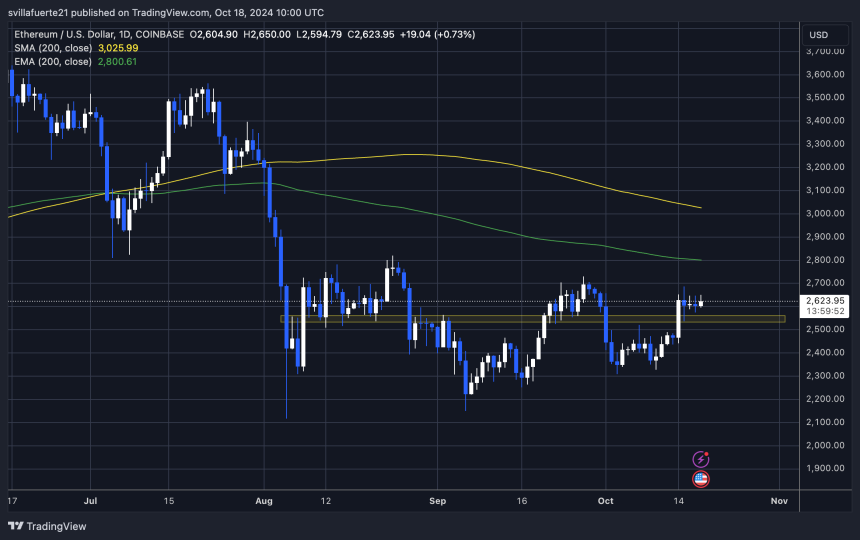
For the bulls to regain momentum, Ethereum needs to push above the current price and reclaim the 200-day exponential moving average (EMA), which is $2,800. This significant level would signal that ETH is back on track for further upside, potentially catching up with Bitcoin’s recent gains.
However, if Ethereum fails to break above this key resistance and reclaim the 200-day EMA, it risks entering a sideways consolidation phase. A failure to hold current levels could lead to a retrace, with support likely around the $2,450 mark.
Related Reading
Traders and investors are closely watching the price action as Ethereum’s next move will determine whether it can break free from its current uncertainty or continue to face resistance in the coming days. As the broader crypto market remains volatile, Ethereum’s ability to hold key levels will be critical for its near-term outlook.
Featured image from Dall-E, chart from TradingView
Ethereum
Ethereum Trades At Bear Market Lows: Fundamentals Signal Major Undervaluation

Reason to trust

Strict editorial policy that focuses on accuracy, relevance, and impartiality
Created by industry experts and meticulously reviewed
The highest standards in reporting and publishing
Strict editorial policy that focuses on accuracy, relevance, and impartiality
Morbi pretium leo et nisl aliquam mollis. Quisque arcu lorem, ultricies quis pellentesque nec, ullamcorper eu odio.
Ethereum is trading below critical resistance levels after enduring weeks of heavy selling pressure and lackluster performance. Since breaking below the psychological $2,000 mark, the price has dropped more than 21%, signaling growing uncertainty among short-term investors. This decline has raised questions among market participants, especially as Ethereum’s on-chain fundamentals remain robust.
Related Reading
Top analyst Ted Pillows shared insights suggesting that ETH is now trading near bear market lows—yet the network has never looked stronger. Over 95% of all stablecoin transactions are processed on Ethereum, and it still leads in Total Value Locked (TVL) across DeFi and Real World Asset (RWA) protocols. It is also the only altcoin with an approved spot ETF in the US, and numerous upgrades are lined up to improve its speed and reduce transaction costs.
Despite these strengths, Ethereum’s price remains suppressed, leading to growing speculation: is this just market sentiment at play, or could it reflect coordinated manipulation to shake out weak hands before a reversal? As Ethereum continues to dominate the utility narrative in crypto, many long-term holders see this downturn as a strategic accumulation zone, while others brace for more downside.
Ethereum Fundamentals Shine Despite Bearish Market Conditions
Ethereum is facing a critical test as it trades near major demand levels while macroeconomic uncertainty deepens. Global tensions persist as US President Donald Trump escalates his trade war with China. The recent 90-day tariff pause for all countries except China has done little to ease market fears. As economic pressure builds between the world’s two largest economies, investors are increasingly turning away from high-risk assets like crypto, driving volatility across digital markets.
Ethereum, like the broader crypto market, has suffered under this weight. The asset is now hovering just above bear market lows after a prolonged decline, prompting concerns over its short-term price action. Yet, despite the technical weakness, Pillows points to Ethereum’s strong fundamentals as a reason to remain optimistic.
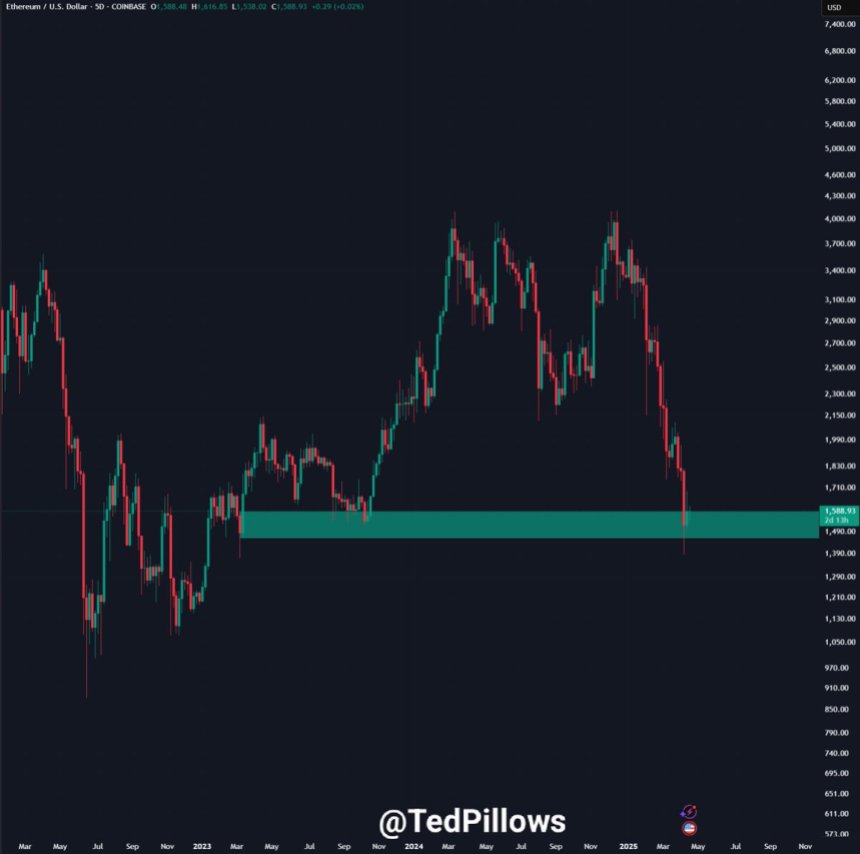
According to Pillows, Ethereum remains the backbone of the decentralized finance (DeFi) ecosystem. It processes over 95% of all stablecoin transactions, commands the highest Total Value Locked (TVL), and leads the charge in Real World Asset (RWA) tokenization. It’s also the only altcoin the US has approved for a spot ETF, adding institutional legitimacy.
With several protocol upgrades ahead aimed at improving scalability and reducing costs, Pillows believes Ethereum’s current valuation could represent a long-term buying opportunity. As he puts it: if you believe in fundamentals, ETH remains the top bet among altcoins.
Related Reading
ETH Price Stuck In Range: Bulls Eye $1,800 Breakout
Ethereum is trading at $1,590 after several days of choppy price action between $1,500 and $1,700. The market remains stuck in this narrow range as bulls struggle to regain momentum amid broader macroeconomic uncertainty. The inability to reclaim key resistance zones has kept ETH under pressure, and a decisive breakout is needed to shift sentiment.

Bulls are currently eyeing the 4-hour 200-day Moving Average (MA) and Exponential Moving Average (EMA), both sitting near the $1,800 level. Reclaiming this zone would mark a major short-term victory for buyers and could signal the beginning of a recovery phase. A clean break above $1,800 would also invalidate the current lower-high structure and potentially drive ETH toward higher supply areas near $2,000.
Related Reading
However, the downside risks remain. If Ethereum fails to hold above current support levels and dips below $1,550, the next leg could send the asset beneath the $1,500 mark. For now, the $1,500–$1,800 corridor defines Ethereum’s battleground, and traders are closely watching for a breakout that sets the next major direction.
Featured image from Dall-E, chart from TradingView
Ethereum
Ethereum Price Stalls In Tight Range – Big Price Move Incoming?

Reason to trust

Strict editorial policy that focuses on accuracy, relevance, and impartiality
Created by industry experts and meticulously reviewed
The highest standards in reporting and publishing
Strict editorial policy that focuses on accuracy, relevance, and impartiality
Morbi pretium leo et nisl aliquam mollis. Quisque arcu lorem, ultricies quis pellentesque nec, ullamcorper eu odio.
Ethereum is trading at critical levels after enduring weeks of aggressive selling pressure. Since retracing below the key $2,000 mark, the second-largest cryptocurrency has struggled to regain bullish momentum. Currently down 21% from that level, ETH continues to hover near $1,580, reflecting a clear lack of conviction from both buyers and sellers.
Related Reading
The market has entered a period of extreme indecision. According to top analyst Daan, Ethereum’s price has remained notably compressed, barely moving over the past two days. This type of consolidation often precedes sharp price action in either direction, and traders are watching closely for signs of a breakout or breakdown.
Macroeconomic uncertainty continues to influence investor sentiment, with global trade tensions and monetary policy concerns keeping pressure on risk assets like Ethereum. For now, bulls must reclaim the $1,850 resistance zone to confirm a trend reversal, while a drop below $1,500 could open the door to deeper losses.
As volatility builds in the background, the current compression could be the calm before a storm—setting the stage for Ethereum’s next decisive move. Will it break out to the upside, or is more downside in store?
Ethereum Compression Signals Breakout As Macro Pressure Builds
Ethereum is facing a critical test as it trades at compressed levels following weeks of sustained selling pressure. The broader crypto market remains under pressure as global tensions escalate. US President Donald Trump’s trade war with China continues to shape macroeconomic sentiment, leaving investors cautious across all high-risk asset classes.
Despite last week’s announcement of a 90-day tariff pause for all countries except China, uncertainty remains. The unresolved status of US-China trade relations continues to weigh on markets and is one of the primary factors driving hesitation in price movement. For Ethereum, this has translated into extremely low volatility and a stalled price structure.
Daan shared insights suggesting that Ethereum’s price has been “extremely compressed” and has not shown meaningful movement for the better part of two days. According to Daan, this type of compression usually precedes a significant breakout—though the direction of that move remains unknown.
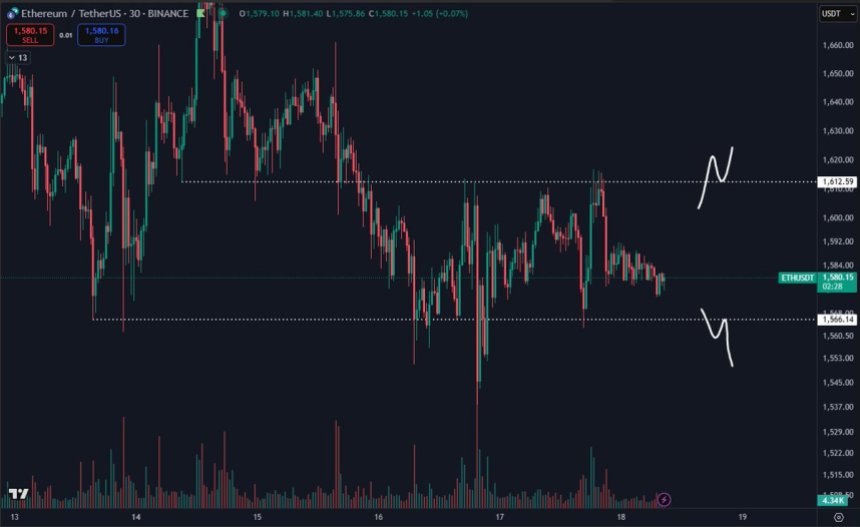
Investors and traders alike are closely monitoring this setup, as compressed price action typically leads to large, momentum-driven shifts. With broader macro risks still in play, Ethereum’s next move could define the short-term trend and set the tone for the market in the weeks ahead.
Related Reading
ETH Bulls Aim To Regain Control
Ethereum is trading at $1,590 after several days of sideways price action, hovering between support at $1,550 and resistance near $1,700. Despite holding above the lower end of this range, ETH has struggled to generate the momentum needed to break out and confirm a short-term recovery.
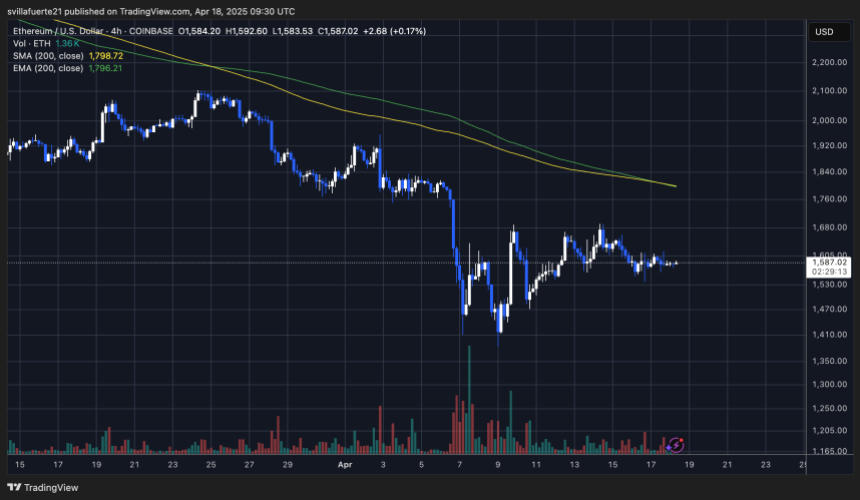
For bulls to establish a stronger position, ETH must push above the 4-hour 200-day moving average (MA) and exponential moving average (EMA), both of which continue to act as dynamic resistance. A breakout above these indicators could trigger renewed interest from traders and signal the beginning of a recovery phase.
However, the true test lies at the $2,000 level—a major psychological and technical resistance zone. Reclaiming this level would mark a shift in market sentiment and open the door to higher targets.
Related Reading
On the downside, failure to gain ground above the current range and a drop below $1,550 could quickly drag ETH below $1,500, increasing the risk of a deeper correction. For now, Ethereum remains in a consolidation phase, and the next decisive move will likely dictate whether bulls regain control or if sellers push prices into lower demand zones.
Featured image from Dall-E, chart from TradingView
Ethereum
Ethereum Fee Plunges To 5-Year Low—Is This A Bottom Signal?


On-chain data shows the Ethereum transaction fee has dropped to the lowest level in years recently. Here’s what this could mean for ETH’s price.
Ethereum Average Fees Now Valued At Just $0.168
In a new Insight post, the on-chain analytics firm Santiment has discussed the latest trend in the Average Fees of Ethereum. The “Average Fees” is a metric that, as its name suggests, keeps track of the average amount of fees that senders on the ETH network are attaching with their transactions.
This indicator’s value directly correlates to the amount of traffic that the blockchain is dealing with. The reason behind this lies in the fact that the network only has a limited capacity to handle transfers.
When the chain is busy, transfers can remain stuck in waiting until the transactions ahead of them clear out. Those who want their transactions to be processed ASAP can choose to attach a larger-than-average fee, so that the validators prioritise them.
In times of especially high traffic, this kind of competition among users can quickly drive the Average Fees up to significant levels. When there is little activity, however, senders have little incentive to pay any notable amount of fees, so the metric’s value can remain low.
It would appear that Ethereum has been witnessing the latter kind of conditions recently, as the Average Fees have registered a drop.
Looks like the value of the metric has declined to a low level in recent days | Source: Santiment
As displayed in the above graph, the Ethereum Average Fees have fallen to a low of $0.168 recently, which is the lowest that it has been since 2020. This means that activity on the network is historically low at the moment.
According to the analytics firm, this may not actually be so bad from a trading perspective, as low fee periods can often precede rebounds in the cryptocurrency’s price.
Below is a chart that shows an example of this trend in action:

The past trend in the transaction fees of ETH | Source: Santiment
As is visible in the above graph, the Ethereum Average Fees falling under the $1 mark back in 2023 led to bullish momentum for the asset. The explanation behind this pattern may lie in the fact that low-fee periods can indicate disinterest from the crowd.
Historically, ETH and other digital assets have tended to move in a way that goes contrary to the expectation of the majority. This means that a lack of optimism can lead to rebounds, while excessive hype can result in tops. From the chart, it’s apparent that ETH’s Q1 2024 top came as the metric surpassed $15, indicating a plethora of excitement.
“Generally, fee levels under $1 are a pretty promising sign that the crowd has become disinterested,” notes the analytics firm. “Just remember that there is no set guaranteed “bottom” or “top” level every time fee costs breach below or above a certain level.”
ETH Price
At the time of writing, Ethereum is trading around $1,600, up more than 1% in the last 24 hours.
Looks like the price of the asset hasn't moved much recently | Source: ETHUSDT on TradingView
Featured image from Dall-E, Santiment.net, chart from TradingView.com

Editorial Process for bitcoinist is centered on delivering thoroughly researched, accurate, and unbiased content. We uphold strict sourcing standards, and each page undergoes diligent review by our team of top technology experts and seasoned editors. This process ensures the integrity, relevance, and value of our content for our readers.
-

 Altcoin14 hours ago
Altcoin14 hours agoAnalyst Reveals Dogecoin Price Can Reach New ATH In 55 Days If This Happens
-

 Market18 hours ago
Market18 hours agoCardano (ADA) Moves Sideways, But Bullish Shift May Be Brewing
-

 Market24 hours ago
Market24 hours agoDespite an 18% Drop, XRP’s Exchange Supply Hits Lows—Bullish Setup Ahead?
-

 Market21 hours ago
Market21 hours agoXRP Consolidation About To Reach A Bottom, Wave 5 Says $5.85 Is Coming
-
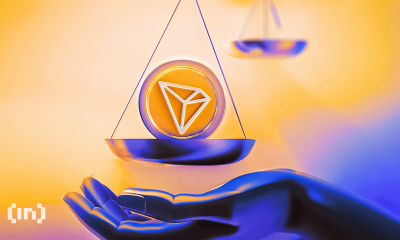
 Market20 hours ago
Market20 hours agoCanary Capital Aims to Launch TRON-Focused ETF
-

 Altcoin23 hours ago
Altcoin23 hours agoChainlink Price To Hit $26 If LINK Breaks Past This Crucial Level
-

 Market14 hours ago
Market14 hours agoBinance Mandates KYC Re-Verification For India Users
-
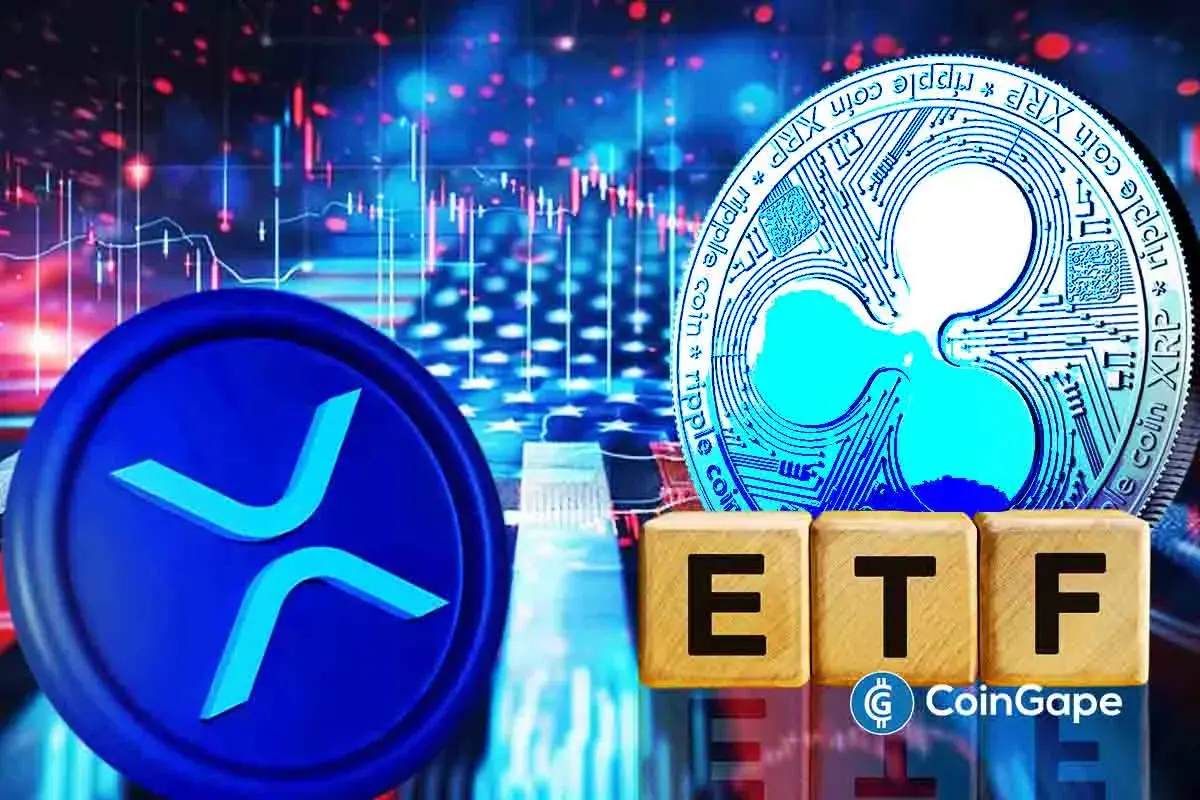
 Altcoin18 hours ago
Altcoin18 hours agoXRP ETF Approval Could Spark a ‘Perfect Storm’ for Ripple Coin: Expert



















